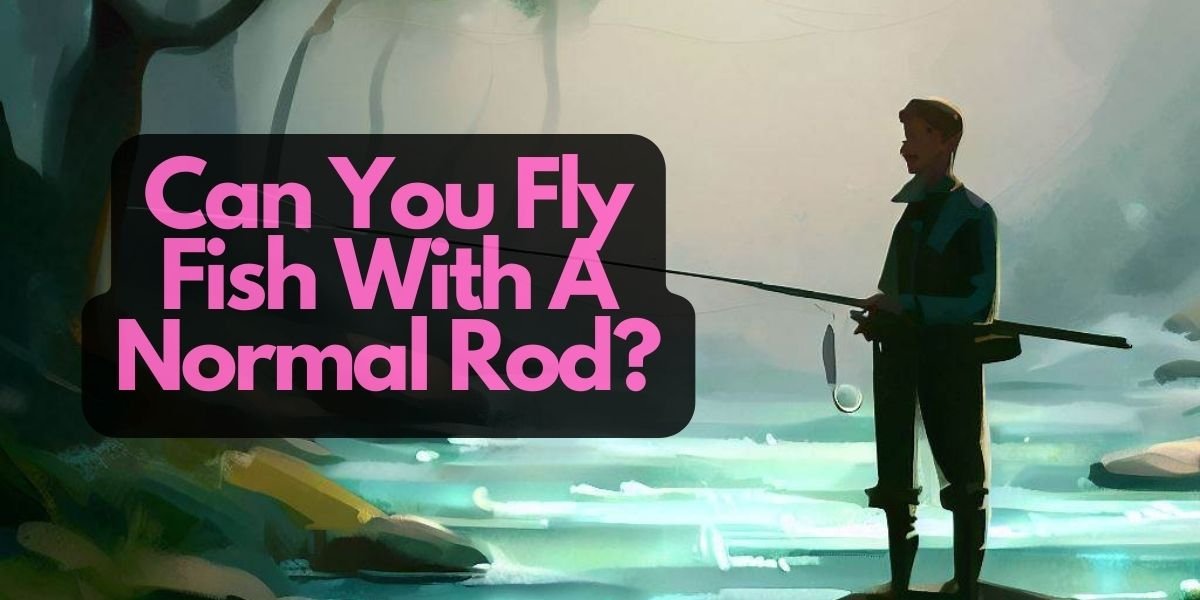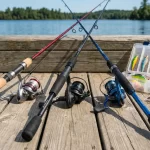Fly fishing is a unique and rewarding sport that can be enjoyed by both novices and experts alike.
While fly fishing may seem intimidating at first, it’s actually quite easy to get started with the right equipment.
Today, we’re looking at the question of whether you can fly fish with a normal rod.
The answer is yes, but there are some important considerations to keep in mind before setting out on your next fly-fishing adventure.
The Benefits Of Fly Fishing
Fly fishing is an art form, enjoyed by a growing number of anglers worldwide. It’s a method of fishing that offers numerous benefits over traditional forms of fishing.
Take the case of Frank, who was an avid traditional fisherman but switched to fly fishing after being introduced to its unique casting techniques.
After only one week on the water, Frank noticed improvements in his cast distance and accuracy compared to what he had previously achieved with his regular rod.
One of the most appealing features of fly fishing is the ability to customize your tackle according to your own preferences.
This can be done through fly tying, where you tie your own flies using materials such as fur, feathers, and thread. The unique patterns and colors you create will draw fish that wouldn’t otherwise pay attention to traditional bait or lures.
It’s also much more rewarding than simply buying pre-made flies from a store since it gives you complete control over the look and feel of your lures.
The accessibility and affordability of fly fishing make it an attractive method for beginners as well as experienced anglers alike. With minimal investment in gear and instruction, you can quickly learn the basics and make progress toward becoming a proficient caster in no time.
In addition to honing your skills on the water, there are many types of classes available both online and offline which can help you understand different techniques for successful catch-and-release fishing practices.
With these resources at hand, even novice anglers have access to top-notch advice from experienced fishermen – so it’s easy for anyone to get started without having to invest too much money or time upfront.
Overall, fly fishing presents anglers with countless opportunities for success while also providing an enjoyable experience on the water.
As Frank found out during his first week on the water, utilizing specialized casting techniques along with customized flies can lead to improved performance when targeting fish in any environment.
Understanding these basics is key if you want to enjoy fly fishing at its fullest potential and make lasting memories along the way!
See also: How To Fly Fish With A Spinning Rod?
Understanding The Basics Of Fly Fishing
Fly fishing is an enjoyable and challenging method of angling. It’s important to understand the basics of fly fishing in order to have a successful outing.
Knot tying and flies tying are essential skills to master when starting out with fly fishing. Learning how to tie knots properly is essential for constructing the end tackle, such as attaching the leader, tippet, and fly line. Properly tied knots will ensure that your leader material won’t slip or break if it gets snagged on an obstacle in the water.
In addition to knot tying, learning how to tie flies is also a critical part of fly fishing. A great deal of time can be spent crafting custom flies that resemble natural insects found in streams and rivers.
Understanding the anatomy of certain aquatic insects can help you make more realistic patterns which will help you catch more fish. Knowing what type of insect hatches are occurring at any given time can also help you select appropriate artificial patterns for success on the water.
Practicing both knot tying and flies tying before heading out on the water is key to having a successful day of fly fishing.
Once these basic skills have been mastered, choosing the right equipment will be much easier, allowing anglers to focus on honing their casting technique and enjoying their time outdoors.
Choosing The Right Equipment
Fly fishing is much more than just casting a line into the water – it is an art form, borne from the deep love of angling and outdoor life. The right equipment can make or break your fly fishing experience, so it is important to choose carefully.
When it comes to choosing a rod for fly fishing, there are several factors to consider. Casting techniques need to be taken into account – and the right rod should suit your style of casting perfectly.
Different fly patterns require different types of rods as well, so be sure to pick one that suits the type of flies you plan on using.
The quality of your rod will also make a huge difference in how successful you are when out on the water. After all, this is an investment that will last you years if you take care of it properly – so don’t hesitate to invest in something that won’t let you down!
Different Types Of Fly Fishing Rods
Travel fly fishing rods are a great option for anglers who need to cover a lot of ground. They’re light, compact, and can easily be packed away in a backpack.
Double-handed fly fishing rods are preferred by those who prefer to cast with two hands. They’re ideal for longer casts and more accurate presentations.
Tenkara rods are a traditional form of Japanese fly fishing that doesn’t require a reel. They’re incredibly light, and allow anglers to cast further with fewer false casts. They’re perfect for anglers who need to cover a lot of water.
All of these rods have their unique benefits, and it’s important to have the right one for the job!
Travel Fly Fishing Rods
Ah, the travel fly fishing rod. A must-have for any serious angler who loves to explore the world’s best fishing spots.
Its compact and lightweight design makes it a great choice for those looking to hit the road in search of their next adventure. But don’t let its size fool you; these rods are designed with precision and can be cast with accuracy and finesse.
When choosing your travel rod, pay close attention to the casting technique and line selection. A good casting technique is essential when using a travel rod, as it will allow you to make accurate casts in tight quarters or challenging conditions. Line selection is just as important; choose a line that is suitable for your target species and environment.
This will ensure that you get maximum performance from your rod and reel setup.
No matter where you go, having a reliable travel fly fishing setup can make all the difference when it comes time to battle big fish in unfamiliar waters. With a little practice and some careful equipment selection, you’ll be ready to take on any challenge that comes your way!
Double-Handed Fly Fishing Rods
If you’re looking for the ultimate in casting accuracy and fly patterns, then double-handed fly fishing rods are the way to go. These powerful rods offer a greater range of casting flexibility and can help you make precision casts in tight spots or challenging conditions.
With two hands on the rod, you can achieve a level of accuracy that single-handed rods simply cannot match. Plus, their length helps increase your line speed, allowing you to cast farther and with better accuracy.
Whether you’re fishing for trout or chasing trophy bass, having a double-handed fly rod in your arsenal will give you an edge. The only downside to double-handed fly fishing rods is that they require more skill than single-handed rods to use properly.
As such, these types of rods may not be suitable for beginners who are just starting out in the sport. But with practice and patience, anyone can learn how to effectively use a double-handed rod and reap the rewards of improved casting accuracy and distance.
So if you’re looking to take your fly fishing game to the next level, then investing in a quality double-handed rod is definitely worth considering. With a little practice and dedication, you’ll be ready to take on any challenge that comes your way!
Tenkara Rods
If you’re looking for an even more specialized casting technique, then Tenkara rods are worth exploring.
These Japanese-style rods don’t rely on a reel and instead use a fixed line length to deliver fly patterns with incredible accuracy.
Tenkara rods are incredibly lightweight, making them perfect for stream fishing where weight is essential.
Plus, they’re extremely easy to use and can be mastered quickly by any angler who’s willing to put in the effort.
With their long reach and powerful casts, Tenkara rods allow you to target fish in places that were once inaccessible when using other types of fly fishing rods.
No matter what type of water you’re fishing in, having one of these unique rods will give you an edge that no other rod can match.
So if you want the ultimate in accuracy and precision while pursuing your favorite species, then pick up a Tenkara rod today!
See also: Top 5 Best Tenkara Rods for Backpacking
Essential Fly Fishing Techniques
Fly fishing is an art form that requires skill, patience, and a keen eye. To become a successful fly fisher, mastering the basics is essential. Here are the core fly fishing techniques you should know before heading to the river:
- Casting: This involves propelling the line and lure into the water with a single motion. The most common types of casts used in fly fishing are forward casts, back casts, and roll casts.
- Line Management: This refers to how you manage your line when casting and retrieving it. It’s important to practice proper line management to ensure your fly lures are presented correctly in the water.
- Fly Selection: Knowing what types of flies to use for different species of fish can be tricky. Experimenting with different patterns and sizes is key to success in catching fish on the fly.
- Knot Tying: You must learn how to properly tie knots if you want to get serious about fly fishing. A few basic knots such as the improved clinch knot or surgeon’s knot will help you secure your flies securely to your leader or tippet so they can stay on during casting and retrieval.
Conclusion
Fly fishing is an enjoyable and rewarding experience. It can take years to master, but the journey is often worth it. With the right equipment and techniques, you can enjoy a successful day of fly fishing.
There’s nothing quite like the thrill of feeling a fish catch your line – it’s a moment that will stay with you forever! To get started, take some time to learn the basics and experiment with different rods and techniques.
With patience and dedication, you’ll be able to cast like a pro in no time. So what are you waiting for? Grab your rod and hit the water – let’s go fishin’!








